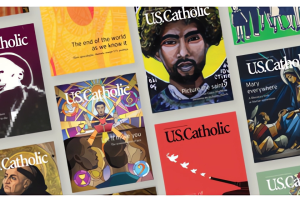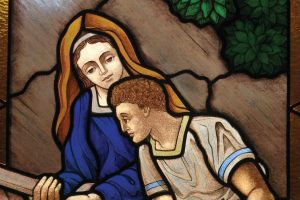c. 2013 Religion News Service
WASHINGTON (RNS) Meet “Our Lady of Perpetual Exhaustion,” a saint everyone probably can relate to.
The chaos of everyday life and the methods we use to overcome it are on display at the “Our Lady of Perpetual Exhaustion” exhibit in two D.C. galleries.
“We all have coping mechanisms,” said Cynthia Farrell Johnson, creator of the exhibit’s theme. “And for most of us, part of our coping mechanism is our spiritual life.”
The exhibit is a joint effort between Wesley Theological Seminary’s Arthur and Marjory Dadian Gallery and the Watergate Gallery.
Each gallery invited artists to create a piece based on this statement: “ … For those who are not particularly religious or spiritual, we do not doubt that there is some type of morning ritual used to get motivated, to get energized or to get the creative and innovative juices flowing. … What is your interpretation of Our Lady of Perpetual Exhaustion?”
Johnson has two versions of her artistic interpretation of “Our Lady of Perpetual Exhaustion,” one in each gallery.
Her mixed-media piece at the Dadian Gallery pictures a woman praying over a table covered with baskets of fruit and soup cans. Chaos surrounds her, but the expression on her face is serene. The three theological virtues of faith, hope and love are written on the cans. The word “patience” appears twice on the boxes in front of her.
The Dadian Gallery displays pieces from 20 artists, while the Watergate Gallery has pieces from 33. Both exhibits end in early October.
Johnson developed the theme two years ago when she was an artist-in-residence at Wesley’s Henry Luce III Center for the Arts and Religion. All the while she worked at the State Department, had a son at home and was trying to paint — a chaotic life.
One day Johnson joked to a friend about praying to the “Lady of Perpetual Exhaustion.” The friend laughed and the idea was formed. Another friend of Johnson’s, artist Helen Zughaib, brought the Watergate Gallery on board with the project.
The exhibit, Johnson said, is intended to “help people see the absurdity of our existence when we try to pile too many things in one day.”
Dale Johnson, owner of Watergate Gallery and Frame Design, said that although many of the pieces revolve around the idea of overcoming exhaustion, most artists put a whimsical or humorous spin on the concept.
“Everyone can relate to it,” she said. “It’s so colorful — sort of a happy show.”
Although Wesley is affiliated with the United Methodist Church, artists exhibited came from a variety of religious or nonreligious backgrounds.
Theologians can learn much about God and humanity from artists, said Deborah Sokolove, director of the Center for the Arts and Religion.
“Art is important to theology because it grounds us in the material and in the incarnational reality of what it means to be human on the earth,” Sokolove said.
Sokolove said she hopes the current exhibit will promote exactly that sort of dialogue.
“I always think that ceramists are the most brave of artists,” Sokolove said while describing the spiritual significance of “Head in the Clouds,” a work in porcelain by Ginger Henry Geyer that includes elements of women’s everyday lives: hair dryers, the Eucharist and Dolly Parton.
Sokolove referred to the Christian idea of giving up oneself to be refashioned by God.
“They have to submit their work to the fire. That in itself is a faith statement. … (Ceramicists) close the door and they don’t know what will come out.”










